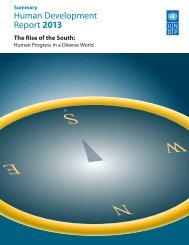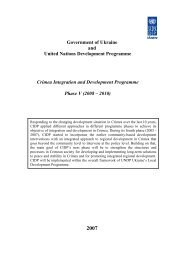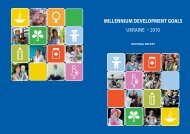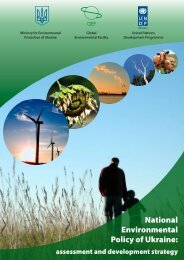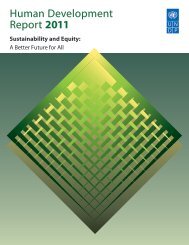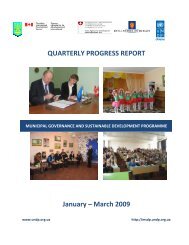E N S W - United Nations Development Programme
E N S W - United Nations Development Programme
E N S W - United Nations Development Programme
You also want an ePaper? Increase the reach of your titles
YUMPU automatically turns print PDFs into web optimized ePapers that Google loves.
Latin America, in<br />
contrast to overall global<br />
trends, has seen income<br />
inequality fall since 2000<br />
Figure 4<br />
the number and the intensity of over lapping<br />
human deprivations in health, education and<br />
standard of living. For many of the rapidly<br />
growing countries of the South, the population<br />
living in multidimensional poverty exceeds<br />
that living in income poverty. And income inequality<br />
is on the rise in many countries. Based<br />
on calculations for the Inequality-adjusted<br />
HDI for 132 countries in 2012, almost a quarter<br />
of HDI value, 23%, is lost to inequality.<br />
Between 1990 and 2005, Inequality- adjusted<br />
HDI trends for 66 countries show that overall<br />
inequality declined only marginally, because<br />
declining inequality in health and education<br />
was offset by rising inequality in income. 12 Latin<br />
America, in contrast to overall global trends, has<br />
seen income inequality fall since 2000 but still<br />
has the most unequal distribution of all regions.<br />
Sub-Saharan Africa has the most inequality in<br />
health, and South Asia in education.<br />
Massive expansion of<br />
the middle class<br />
The middle class in the South is growing<br />
rapidly in size, income and expectations.<br />
The middle class in the South is projected to continue to grow<br />
Middle class population (billions)<br />
2009<br />
World:<br />
1.845 billion<br />
Europe<br />
Central and South America<br />
2020 2030<br />
World:<br />
3.249 billion<br />
.032<br />
.057<br />
.105<br />
.165<br />
.181<br />
.664<br />
.251<br />
.703<br />
.338 .333<br />
.525<br />
1.740<br />
Asia–Pacific<br />
Middle East and North Africa<br />
World:<br />
4.884 billion<br />
.107<br />
.234<br />
.313<br />
.322<br />
3.228<br />
.680<br />
North America<br />
Sub-Saharan Africa<br />
Note: The middle class includes people earning or spending $10–$100 a day (in 2005 purchasing power parity terms).<br />
Source: Brookings Institution 2012.<br />
Between 1990 and 2010, the South’s share of<br />
the global middle class population expanded<br />
from 26% to 58%. By 2030, more than 80%<br />
of the world’s middle class is projected to be<br />
residing in the South and to account for 70%<br />
of total consumption expenditure. 13 The Asia–<br />
Pacific Region will host about two-thirds of<br />
the world’s middle class by 2030, Central and<br />
South America about 10% and Sub-Saharan<br />
Africa 2% (figure 4). Within Asia, China and<br />
India will account for more than 75% of the<br />
middle class as well as its share of total consumption.<br />
Another estimate is that by 2025,<br />
annual consumption in emerging market economies<br />
will rise to $30 trillion, from $12 trillion<br />
in 2010, with the South home to three-fifths<br />
of the 1 billion households earning more than<br />
$20,000 a year. 14 The continued expansion of<br />
the middle class is certain to have a profound<br />
impact on the world economy.<br />
The sheer number of people in the South—<br />
the billions of consumers and citizens—<br />
multiplies the global human development<br />
consequences of actions by governments,<br />
companies and international institutions in the<br />
South. The South is now emerging alongside<br />
the North as a breeding ground for technical<br />
innovation and creative entrepreneurship. In<br />
North−South trade the newly industrializing<br />
economies have built capabilities to efficiently<br />
manufacture complex products for developed<br />
country markets. But South−South interactions<br />
have enabled companies in the South to<br />
adapt and innovate with products and processes<br />
that are better suited to local needs. This is<br />
creating new business models, as companies<br />
develop products that can reach customers<br />
with lower disposable incomes. The rise of the<br />
South is also diffusing technology through new<br />
models of extensive coverage with low margins,<br />
which serve lower income households and<br />
reach a large number of consumers in markets<br />
that have weak support infrastructure.<br />
The world is also becoming more educated.<br />
Assuming a robust increase in school enrolment<br />
rates, the share of the world’s people<br />
older than 15 who lack formal schooling is<br />
projected to shrink from 12% in 2010 to 3% in<br />
2050, and the share with secondary or tertiary<br />
education will climb from 44% in 2010 to 64%<br />
in 2050. Furthermore, the digital divide is rapidly<br />
narrowing, giving people from everywhere<br />
14 | HUMAN DevELOPMENT REPORT 2013



